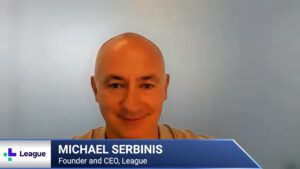In healthcare, “personalized” often still means grouping people into broad categories — diabetics, 50-something women, post-op knee patients. League’s goal is different: use good data and AI to shape guidance for each individual, based on their exact health history, behaviors, and preferences.
Mike Serbinis, Founder and CEO of League, has spent decades designing technology for global scale. In healthcare, his focus has zeroed in on a deceptively simple goal: make it possible to engage every patient or member as an audience of one. His approach blends practical fixes for industry bottlenecks with the long-term vision of influencing real behavior change.
Key Takeaways
- AI-Driven Personalization Must Reach the “N of 1” Level. Generic protocols won’t cut it—AI can now tailor recommendations for each individual by blending EMR, claims, self-reported, wearable, and synthetic data to drive real action.
- Stop Waiting for “Perfect” Data. Health IT leaders often delay engagement initiatives until their data environment is flawless, but that day never comes. Serbinis strongly recommends starting immediately, iterate, and improve as you go.
Personalization Means N of 1
For Serbinis, the future of healthcare lies in an N of 1.
This vision comes from years of building League to become a leader in engaging and encouraging patients as well as members to take the next, most appropriate step in their care/health. That could be booking their next appointment, achieving a dietary goal, keeping up with medications – anything that is aligned to the individual’s care plan or treatment pathway.
“The idea of an N of 1 means leveraging an enormous amount of data,” explained Serbinis. “Data from internal systems, but also self-reported data, wearable data, and frankly, a lot of synthetic data. All of that is needed to drive personalization that people will actually follow through with.”
That last point is key. The goal isn’t just accurate targeting (which is the goal of broad-based population health initiatives), but to designing outreach that lands with enough relevance to spark a click, a booking, a refill, a lifestyle change.
Serbinis was quick to point out that personalization depends on having usable but not perfect data.
Don’t Wait for “Data Utopia”
To achieve League’s vision of an N of 1 good, but not perfect, health data is required.
“Companies often think they need to wait for this one magical moment where their data is in a perfectly magical state,” Serbinis said. “That never comes. You can’t wait. You have to start.”
Even with incomplete or messy datasets, League is already creating individualized recommendations that get acted on. The precision of those recommendations improves over time as systems and data sources improve. Serbinis strongly recommends starting with what you have already and iterating. “Engagement should start immediately,” he said.
The League Advantage
League’s work shows that effective personalization can be built on existing data assets, even when they are incomplete. As Serbinis noted, “Last year we processed north of a hundred petabytes of data, which is something like 850 years of continuous HD video equivalent… We have a natural and growing advantage to get better at predicting and getting people to engage.”
By starting with the data they have, rather than waiting for a mythical perfect dataset, League has shown that individual-level personalization can happen today, bringing healthcare closer to an N of 1 reality.
Learn more about League at https://league.com/
Listen and subscribe to the Healthcare IT Today Interviews Podcast to hear all the latest insights from experts in healthcare IT.
And for an exclusive look at our top stories, subscribe to our newsletter and YouTube.
Tell us what you think. Contact us here or on Twitter at @hcitoday. And if you’re interested in advertising with us, check out our various advertising packages and request our Media Kit.



